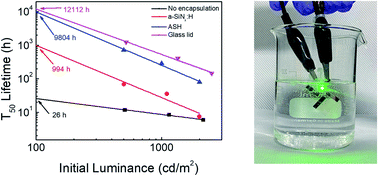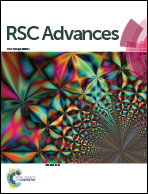Thin film encapsulation for quantum dot light-emitting diodes using a-SiNx:H/SiOxNy/hybrid SiOx barriers
Abstract
A facile thin film encapsulation (TFE) method having a triple-layered structure of a-SiNx:H/SiOxNy/hybrid SiOx (ASH) on QD-LEDs was performed utilizing both reproducible plasma-enhanced chemical vapor deposition (PECVD) and simple dip-coating processes without adopting atomic layer deposition (ALD). The ASH films fabricated on a polyethylene terephthalate (PET) substrate show a high average transmittance of 88.80% in the spectral range of 400–700 nm and a water vapor transmission rate (WVTR) value of 7.3 × 10−4 g per m2 per day. The measured time to reach 50% of the initial luminance (T50) at initial luminance values of 500, 1000, and 2000 cd m−2 was 711.6, 287.7, and 78.6 h, respectively, and the extrapolated T50 at 100 cd m−2 is estimated to be approximately 9804 h, which is comparable to that of the 12 112 h for glass lid-encapsulated QD-LEDs. This result demonstrates that TFE with the ASH films has the potential to overcome the conventional drawbacks of glass lid encapsulation.



 Please wait while we load your content...
Please wait while we load your content...